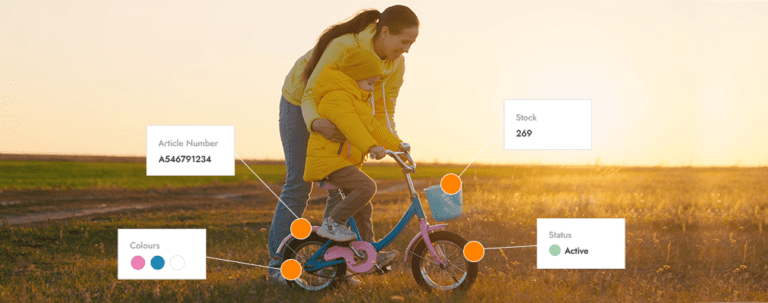dam
19 min
WHAT IS DIGITAL ASSET MANAGEMENT (DAM)?
How to Intelligently Manage Your Digital Assets
Today, it is easier than ever to create digital assets. Especially in large marketing departments, a large number of files accumulates over the years. Keeping track of them all and navigating huge quantities of data is a major challenge. With Digital Asset Management, you can make life easier for your employees and stay in control of your data. In this article, we explain what it is, how it works, and what concrete benefits Digital Asset Management has to offer.
Table of Contents
Definition: What Is Digital Asset Management (DAM)?
Digital Asset Management (DAM) encompasses all the processes surrounding a digital asset, such as creation, administration, organization, and distribution. A DAM system supports you with the use of content throughout the content lifecycle:
- Creation
- Editing
- Storage
- Administration
- Distribution
- Publication
- Reuse
- Archiving
Assigning meta data comprises a large part of Digital Asset Management. Enrich your digital assets with valuable information, e.g., about licenses or usage rights. This ensures an easily navigable storage system, simplifies searches, and ensures that your content is always used correctly.
Types of Digital Asset Management
There are different types of Digital Asset Management – irrespective of the file format. For example, Video Asset Management is used to manage video content, while Print Asset Management deals with assets for printing and Content Asset Management deals with assets for content marketing.
On the whole, Digital Asset Management consolidates all digital content. Since the content often takes the form of media files, it is also referred to as Media Asset Management.
What are Digital Assets?
Digital assets are all content and media that are stored in a digital format.
These include:
- Photos and images (JPEG, PNG)
- Design files (TIFF, PSD)
- (Vector) graphics (SVG)
- Videos (MP4, MOV)
- Audio files (MP3, WAV)
- Text files and documents (DOC, PDF)
- Presentations (PPT)
- 3D files (STL, OBJ)
- and much more
These files are called “digital assets” because they hold a certain value for companies. For example, a company might invest money and resources in the creation of a product flyer.
In a nutshell, digital assets have three essential characteristics:
- They are stored on-premise, on a server or in the Cloud.
- They come in different formats. These can easily be identified by the file name.
- They contain valuable information – they are digital items of value.
How Software helps with DAM
In contrast to the heavy workload of manual data management, Digital Asset Management via software offers more security, reduced lead times, and control over all the assets in the company. That’s because a modern Digital Asset Management system offers a variety of helpful functions to manage your data and files easily and efficiently:
- AI-supported keywords
- Individual authorization concepts
- Smart interfaces with other systems
- Simple, GDPR-compliant filesharing
- Practical task management
- Clear license management
What Are the Benefits of Digital Asset Management?
Digital Asset Management simplifies, streamlines, and accelerates many processes in your company. It increases the quality of your digital assets, ensures consistent usage, and saves time and money – we have summarized the benefits of Digital Asset Management systems for you below.
1. Time savings
Do your employees waste unnecessary amounts of time looking for suitable digital content and supplying it to others? With a DAM system, there is no need to comb through vast folders of files or send large file attachments to and fro by email.
Instead, you can draw on a well-organized, up-to-date library of files in your Digital Asset Management software. In only a few clicks, you can find the asset you need. The meta data provides an overview of all the most important information, and assets are used exactly as intended.
The big advantage: You reduce your lead times and have more time to focus on creative tasks – such as the development of complex marketing strategies.
2. Reduced employee workload
Saving files in the right folders and finding them again, locating them for colleagues, and adapting the format – these are all everyday tasks that quickly become tiresome for your employees. Employees on the design team will especially appreciate it if you take time-consuming file preparation and management tasks off their hands by implementing a DAM system.
The big advantage: Your employees can concentrate on their areas of expertise, work more productively, and feel more satisfied.
3. Self-service Marketing Material
Modern DAM systems function according to the self-service principle. Thanks to the user-friendly interface and many practical functions, employees can work with them fully independently.
An example: If employees in sales or marketing need a new flyer, they can quickly and easily find the required product images, logos, and other data in the DAM – and always in the right format. This saves the design team an extra job. It’s even easier for employees to create their own marketing materials with smart templates saved in the system. The corresponding content can be dragged and dropped into the template and, already, the new marketing product is ready for printing or publication.
The big advantage: If you have saved smart templates in your system, you can automatically fill out and adapt them with data from the DAM. With pre-made templates and carefully managed media files, you can ensure a consistent brand image at all times.
4. More Control
Thanks to Digital Asset Management, you have complete control over your digital assets. Gather all your photos, documents and videos in a central location, ensure efficient digital archiving of old media files, and always keep track of the latest version. That way, everyone refers to the same database. You create a single source of truth that is trusted for its completeness and actuality.
By using individual authorization concepts and assigning roles, you can determine which groups of people can access which files. Usage histories allow you to trace who has used which asset, where, and when, at all times. This fulfils all the requirements for GDPR-compliant archiving.
The big advantage: You prevent your assets from being used incorrectly, or from being edited, shared, or even deleted without your permission.
5. Sensible License Management
Document license conditions directly on the respective assets, e.g., how, where, and for how long the assets may be used. Thanks to a traffic light system, every employee can see the approval status at a glance. By the way: As soon as the license for an image expires, the DAM automatically sets the traffic light system to “Expired” and the file can no longer be downloaded.
An example: DAM software is the ideal solution for the management of things such as employee photos. If your employees have signed a contract for the use of their photos, you can link it to all the photos of the corresponding employee in the DAM. If the employee revokes their consent for the use of the photos, e.g., after leaving the company, you can easily see which photos are affected. This also lets you trace where the photos are published. That way, you can easily replace or delete them. The big advantage: You always know which uses your data has been approved for, and can see at a glance if a license has expired. The system automatically withdraws usage options at the right time to prevent breaches of the license.
6. Simple Filesharing
Share your saved and comprehensively managed files directly from the DAM system. In one click, you can provide external service providers, employees, and teams with data packages to view or download. Even large data packages are quick and easy to send. This ensures efficient collaboration with external partners.
The big advantage: The DAM system documents which files you have sent to whom. Unlike filesharing providers like WeTransfer, our Digital Asset Management solution is fully GDPR-compliant.
7. Interface with third-party Systems
The DAM serves as a database for many third-party systems. For example, you can connect WordPress, Typo3, or shop systems like Shopware to your Digital Asset Management software. Place images, videos, and other assets on your website via the intelligent interface. Image captions and alternative texts can be edited in the DAM and transferred to the CMS.
A combination of DAM and PIM (Product Information Management) is particularly interesting. PIM acquires all the relevant product information via interfaces and transfers them collectively to your shop system. All the information in your online shop, such as product images, descriptions, and prices, is updated automatically. Now you only need to maintain your product information in one location.
An example: Change the file name and add a suitable image caption and alternative text directly while adding images to your DAM system. Then, if you later integrate images in your website via the interface of your content management system, they are already perfectly search-engine-optimized.
The big advantage: You don’t need to maintain your data twice in different systems.
8. Download files in the appropriate Format
Always provide your audio files, images, videos, or text files in the appropriate format. This can be done with pre-defined download profiles in the DAM system. Simply select the one you need.
An example: Save your images in the system with download profiles for LinkedIn, Facebook, and Instagram. If you want to post the images to the various social media channels, simply download it the corresponding download profile with a click.
The big advantage: Time-consuming manual changes are a thing of the past.
9. Easy searching of Assets
Assign suitable keywords to your digital assets with DAM. Our DAM solutions automatically generates keywords using AI, so that you can organize your assets even more quickly and consistently. OCR text recognition also makes image searches extremely simple.
The big advantage: Effective keywords make searching for suitable assets much easier. For example, with suitable keywords, you can determine whether you already have a certain image. With effective image management, you avoid buying the same license twice.
10. Work Collaboratively
A well-designed Digital Asset Management system facilitates working collaboratively in a team. The management of all your digital assets in one central system prevents data silos.
- The DAM system is ideally suited for project and task management:
- Add notes to your assets.
- Create collections and invite your project team to edit them.
- Create tasks for the asset and assign them to the corresponding employees.
- Visualize your individual approval workflows in the DAM.
The big advantage: All changes and approval workflows are transparently documented and traceable by every user.
11. No double Maintenance
Double data maintenance complicates your work processes and leads to errors. DAM helps you identity and eliminate duplicates with pixel-precision comparison of images.
The 4ALLPORTAL DAM system is based on a modern data model, in which the files are physically displayed only once, but you can access multiple versions of the file. The file is available in different formats via download profiles and in different versions via the usage history.
The big advantage: You no longer waste your resources and storage space on double maintenance of data. Thanks to the many integration options, your data can be managed in one place and fed into different systems, always in the latest version.
12. Better Brand Management
The DAM system ensures that all departments of your company are always working with the same, most up-to-date version of your digital content and media. All the necessary brand assets are available in one place, which makes brand management easier for global companies in particular.
Save your brand specifications in the DAM system, create smart templates in your corporate design, and record all the most important information about the use of your assets in your meta data.
The big advantage: Digital Asset Management helps you ensure a consistent brand image and supports you in building a strong, unique brand.
Who Is Digital Asset Management Suitable For?
Digital Asset Management is basically suited to any company that works with a large quantity of digital assets – especially for:
- Medium-sized companies, large companies, and corporations
- Organizations with large marketing teams
- Agencies that specialize in design or influencer marketing
- Retailers and manufacturers with many products and product images
If you want to stay in control of your media, ensure the consistency of your data, and avoid data chaos, there is no avoiding Digital Asset Management software.
In addition, it may be advisable to use a Product Information Management system (PIM). That way, you always have your product data readily to hand. The 4ALLPORTAL DAM system combines all these functions for comprehensive management of your data and assets. As a result, there is no need to decide between DAM and PIM, and you can access all your data on one platform.
more Blogs for You
FAQs about Digital Asset Management
Digital assets are digitally stored content that holds a particular value for the company. In other words, they are digital items of value. The most common assets include photos, videos, audio files, and text.
The main task of Digital Asset Management (DAM) software is to maintain digital assets. A Digital Asset Management system ensures that all the valuable content in your company is stored in one central location, accompanied by essential meta data, and prepared for correct use.
A Media Asset Management system (MAM) is a software that organizes media files such as videos, music files, or text files. There are many asset management softwares and platforms on the market. MAM systems are also known as a Digital Asset Management systems (DAM).
Asset Management refers to the management of assets such as elaborately produced marketing materials. The goal is to optimally manage, organize, and utilize a company’s assets.
Digital Asset Management (DAM) encompasses all processes related to the management of digital assets. These range from content creation to publishing and archiving.






